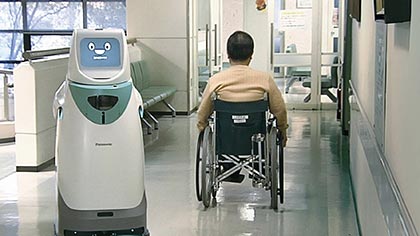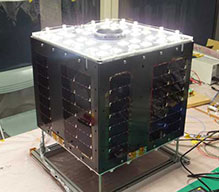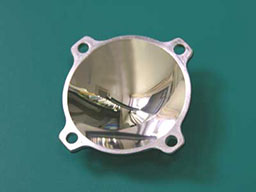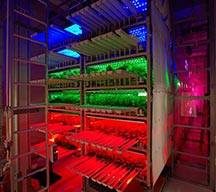Web Japan > Trends in Japan > Tech & Life > Led For Communications Infrastructure
Led For Communications Infrastructure

An image of the experiment in LED visible light communication using street lighting, being undertaken in the Republic of Estonia. (Photo courtesy of LAMPSERVE)
A light-emitting diode (LED) is a type of semiconductor which emits light as electricity flows through it. With its major distinguishing features of product durability and energy efficiency, development of LED that emits white light was made possible after Japanese researchers put blue LED technology into practical use, and, as we all know, LED has a wide range of applications. While LED continues to spread rapidly into familiar areas such as lighting fixtures for offices and homes, backlights for personal computers, signboards and traffic lights all over the town, and illuminations, newly developed technology such as high-capacity communication, danger avoidance sensors, and mechanisms to extend product life without compromising brightness, is bringing innovation to our daily lives and has reached the stage where new developments are finding practical application one after another.
Information exchange with visible light

A communication board which will be installed into street lighting for LED communication. (Photo courtesy of LAMPSERVE)

Transminssion apparatus which converts flashing LED lighting into a digital signal. (Photo courtesy of LAMPSERVE)
A venture company in Naha city, Okinawa Prefecture, has developed a communications system which can communicate large volumes of information at high speed using LED lighting, such as street lights. This system uses “visible light communication” in which airspace is the medium and information is conveyed through visible light, differing from conventional optical communications which use an optical fiber medium. Light from LED lighting, flashing one billion times per second, a high speed hardly comprehensible to us, is converted into a digital signal. Since it can transmit information at the level of 100 mbps, it is likely to become the next generation communications infrastructure, and an alternative to cables or dedicated lines.
Exchange of information outdoors using LED lighting was considered to be difficult due to noise interference in the strong sunlight. However, this company has succeeded in the development of an advanced communication system in which a specialized circuit finely divides a view of the outdoors, captured on camera, into approximately two million, and extracts only the light from the LED lighting conveying information. The construction of a new communication infrastructure requires a huge investment to cover the installation of telegraph poles and electric wiring, but, in the case of LED visible light communication, the only requirement is to mount transceiver modules into street lights which are already in place. This would reduce the cost of infrastructure construction to a one-hundredth.
An experiment to put this technology to practical use has been in progress since the fall of 2013 in the Republic of Estonia. The plan is to provide next-generation high speed internet service to over 60% of all homes by 2020, indicating that the large-scale introduction of LED communication on a national level is also about to become reality.
Communication with space, and even applied to safety measures

A project to apply LED visible light communication to the exchange of information between space and Earth is also underway. Shinshu University, which has undertaken a mission to explore the possibility of communication between Earth and 400-kilometer distant space, will launch its experimental micro satellite “Ginrei”, under development at the university, as early as in the spring of 2014.
Currently, there are more than 3500 artificial satellites orbiting the Earth. In the case of conventional radio wave transmission, problems occur when frequency bands become heavily congested necessitating restrictions on use, but if this experiment is successful, the possibility of using digital communication will certainly spread.
On separate front, an example of how information from LED lighting is proving useful as a safety measure can be seen in the autonomous delivery robot “HOSPI”, developed by a major Japanese consumer electronics manufacturer for use in hospitals. This robot transports drugs or samples around the hospital at a maximum speed of 3.6 kilometers per hour and has been installed with a LED visible light communication system as a safety control system, to detect and avoid restricted areas such as stairs. It uses a mechanism which transmits digital information through LED lighting installed on the ceiling of corridors, flashing at a speed imperceptible to the naked eye, and this information is recognized by sensors on the head of the robot, enabling it to avoid dangers. These state-of-the-art robots can avoid obstacles based on a floor plan which has been input in advance, and by utilizing laser sensors etc., but they have also been installed with a system that uses LED as a fail-safe system to prevent the unlikely occurrence of fall accidents.

The delivery robot “HOSPI”, which can move freely within hospitals, was launched in 2013. Flashing information from LED lighting, which is recognized by sensors in the head of the robot, appears simply as light to the average person, and differs from radio waves in that it has no effect on electronic equipment or the human body. (Courtesy of Panasonic)
Can be used at full power for over 10 years
Remarkable technological innovations using LED lighting technology can also be seen in the field of agriculture. In 2013, the plant factory, which was established in the grounds of Tamagawa University (Tokyo) in collaboration with a business enterprise, began shipping leaf lettuce, grown using LED as the only light source. A “direct cooling method high-power LED” developed by Professor Hiroyuki Watanabe of the Agriculture department of the University was introduced into the plant factory. By attaching the LED directly on to the aluminum base, the cooling effect is increased, thereby preventing deterioration and reduction of output due to heat generation, and enabling continuous lighting at high power. Because it can maintain sufficient power as a light source for plant cultivation over more than 10 years at full power, the cost of replacing equipment can be significantly reduced.
At the plant they have also accumulated the know-how to be able to freely control qualities such as taste or nutritional value, by using different LEDs emitting light of different wavelengths for red, blue or green, depending on the type of plant or the growth conditions. These lettuces have a higher nutrient content of antioxidants, vitamins, and polyphenols etc., compared with traditional lettuces, and have been well received by consumers because of their health benefits.
(February 2014)




